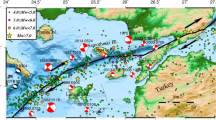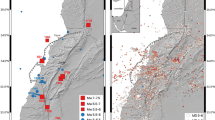Abstract
Areas of low strain rate are typically characterized by low to moderate seismicity. The earthquake catalogs for these regions do not usually include large earthquakes because of their long recurrence periods. In cases where the recurrence period of large earthquakes is much longer than the catalog time span, probabilistic seismic hazard is underestimated. The information provided by geological and paleo-seismological studies can potentially improve seismic hazard estimation through renewal models, which assume characteristic earthquakes. In this work, we compare the differences produced when active faults in the northwestern margin of the València trough are introduced in hazard analysis. The differences between the models demonstrate that the introduction of faults in zones characterized by low seismic activity can give rise to significant changes in the hazard values and location. The earthquake and fault seismic parameters (recurrence interval, segmentation or fault length that controls the maximum magnitude earthquake and time elapsed since the last event or Te) were studied to ascertain their effect on the final hazard results. The most critical parameter is the recurrence interval, where shorter recurrences produce higher hazard values. The next most important parameter is the fault segmentation. Higher hazard values are obtained when the fault has segments capable of producing big earthquakes. Finally, the least critical parameter is the time elapsed since the last event (Te), when longer Te produces higher hazard values.










Similar content being viewed by others
References
Ambraseys N, Simpson K, Bommer J (1996) Prediction of horizontal response spectra in Europe. Earthq Eng Struct Dynam 25:371–400
Atakan K, Midzi V, Toirán BM, Vanneste K, Camelbeeck T, Meghraoui M (2000) Seismic hazard in regions of present day low seismic activity: uncertainties in paleoseismic investigations in the Bree fault scarp (Roer Graben, Belgium). Soil Dynam Earthq Eng 20(5–8):415–427
Atakan K, Moreno B, Furuløkken KA, Berland OJ, Pettersen TK, Temel S, Siame L (2004) Final report of the University of Bergen (Partner # 9), SAFE (Slow Active Faults in Europe: EVG1-2000-22005), Department of Earth Science, University of Bergen, Norway, April 2004, p 76
Atakan K, Ojeda A, Camelbeeck T, Meghraoui M (2001) Seismic hazard analysis results for the Lower Rhine Graben and the importance of paleoseismic data. Netherlands J Geosci (Geologie en Mijnbouw) 80(3–4):213–222
Atakan K, Ojeda A, Meghraoui M, Barka A, Erdik M, Bodare A (2002) Seismic hazard in Istanbul following the August 17, 1999 Izmit and November 12, 1999 Düzce earthquakes. Bull Seismol Soc Am 92(1):466–482
Atakan K, Sørensen MB, Pulido N (2006) Earthquake source complexity in the Marmara Sea and its influence in ground motion simulations. Proceedings of the 1st International Conference on Earthquake Engineering and Seismology (ECEES-2006), Geneva, Switzerland, Sept. 2006. Paper No. 1318
Cornell CA (1968) Engineering seismic risk analysis. Bull Seismol Soc Am 58:1583–1606
Gasperini P, Bernardini F, Valensise G, Boschi E (1999) Defining seismogenic sources from historical earthquake felt report. Bull Seismol Soc Am 89:94–110
Jimenez MJ, García-Fernández, M. and the GSHAP Ibero-Maghreb Working Group: 1999, Seismic hazard assessment in the Ibero-Maghreb region. Annali di Geofisica. 42(6):1057–1066
Jurado MJ, Müller B (1997) Contemporary tectonic stress in the NE Iberia. New results from borehole breakout analysis. Tectonophysics 282:99–115
Litehiser JJ, Marrone JE (1991) Seismic hazard in the area of northeast Spain. Publ.IGN Série Monográfica 8:325–348
Masana E, Villamarín JA, Santanach P (2001a) Paleoseismic results form multiple trenching analysis along a silent fault: the El Camp fault (Tarragona, northeastern Iberian Peninsula). Acta Geológica Hispánica 36:329–354
Masana E, Villamarín JA, Sánchez-Cabañero JG, Plaza J, Santanach P (2001b) Seismogenic faulting in an area of low seismic activity: Paleoseismicity of the El Camp fault (Northeast Spain). Netherlands J Geosci/Geologie en Mijnbouw. 80:229–241
McGuire RK (1993) Computations of seismic hazard. Annali di Geofisica 36:181–200
Ojeda A, Atakan K, Masana E, Santanach P, Jiménez MJ, García-Fernández M (2002) Integration and influence of paleoseismic and geologic data for the seismic hazard evaluation in the Catalan Coastal Ranges, Spain. Soil Dynam Earthq Eng 22:911–916
Perea H, Figueiredo P, Carner J, Gambini S, Boydell K, and participants to Europaleos (2003) Paleoseismological data from a new trench across the El Camp fault (Catalan Coastal Ranges, NE Iberian Peninsula). Ann Geophys 46(5):763–774
Perea H, Masana E, Santanach P (2004a) Determinación del grado de actividad de fallas extensivas en zonas de deformación lenta y su influencia en los estudios de peligrosidad sísmica. Geotemas VI Gongreso Geológico de Expaña, 12–15 Julio 2004 6(3):175–178
Perea H, Masana E, Santanach P (2004b) Estimating fault activity in slow slip rate systems: the eastern Iberian Paninsula. Book of abstracts of the 32nd International Geological Congres, Florence 2004
Perea H, Masana E, Santanach P (2006) A pragmatic approach to seismic parameters in a region with low seismicity: the case of eastern Iberia. Nat Hazards 39:451–477
Pulido N, Ojeda A, Atakan K, Kubo T (2004) Strong ground motion estimation in the Marmara Sea region (Turkey) based on a scenario earthquake. Tectonophysics 391:357–374
Roca E, Guimerà J (1992) The Neogene structure of the eastern Iberian margin: structural constrains on the crustal evolution of the València trough (western Mediterranean). Tectonophysics 203:203–218
Roca E, Sans M, Cabrera L, Marzo M (1999) Oligocene to Middle Miocene evolution of the central Catalan margin (northwestern Mediterranean). Tectonophysics 315:209–233
Santanach P, Masana E, Villamarín JA (2001) Proyecto Datación. Consejo de Seguridad Nuclear, p 159
Schindler A, Jurado MJ, Müller B (1998) Stress orientation and tectonic regime in the northwestern Valencia Trough from borehole data. Tectonophysics 300:63–77
Schwartz DP (1988) Geologic characterization of seismic sources: moving into the 1990’s. Earthquake Engineering and Soil Dynamics II Proceedings. GT Division, ASCE, Park City, Utah, USA; June 1988, p. 42
Schwartz DP, Coppersmith KJ (1984) Fault behavior and characteristic earthquakes: examples from the Wasatch and San Andreas fault zones. J Geophys Res 89:5681–5698
Secanell R (1999) Avaluació de la perillositat sísmica a Catalunya: anàlisi de sensibilitat per a diferents models d’ocurrència i paràmetres sísmics. Doctoral Thesis, Univ Barcelona, p. 335
Secanell R, Goula X, Susagna T, Fleta J, Roca A (2004) Seismic hazard zonation of Catalonia, Spain, integrating random uncertainties. J Seismol 8:25–40
Sørensen, MB, Atakan K, Pulido N (2007). Simulated strong ground motions for the great M 9.3 Sumatra-Andaman earthquake of December 26, 2004. Bull Seismol Soc Am 97:S139–S151
Tassone A, Roca E, Muñoz JA, Cabrera L, Canals M (1996) Evolución del sector septentrional del margen continental catalán durante el Cenozoico. Acta Geológica Hispánica 29:3–37
Wells DL, Coopersmith KJ (1994) New empirical relationships among magnitude, rupture length, rupture area and surface displacement. Bull Seismol Soc Am 84:974–1002
Wesnousky SG (1986) Earthquakes, quaternary faults and seismic hazard in California. J Geophys Res 91(B12):12587–12631
Wessell P, Smith W (1998) New, improved version of the generic mapping tools released. EOS Trans Amer Geophys U 79(47):579
Youngs RR, Coppersmith KJ (1985) Implications of fault slip rates and earthquake recurrence models to probabilistic seismic hazard estimates. Bull Seismol Soc Am 75:939–964
Acknowledgements
The authors are grateful to Aníbal Ojeda for his help during the seismic hazard computations and to the two anonymous reviewers for their helpful comments. This study was supported by the European project SAFE (contract n° EVG1-CT-2000-00023) and by the Consolider-Ingenio 2010 programme, under CSD2006-0004 “Topo-Iberia”. Hector Perea is indebted to the Dept. of Earth Sciences at the Universitetet i Bergen for all the facilities provided during his stay in Bergen. Seismic hazard computations were performed using the software CRISIS 99 kindly provided by Mario Ordaz. Some figures were prepared using the public domain Generic Mapping Tools GMT (Wessel and Smith 1998).
Author information
Authors and Affiliations
Corresponding author
Rights and permissions
About this article
Cite this article
Perea, H., Atakan, K. Influence of slow active faults in probabilistic seismic hazard assessment: the northwestern margin of the València trough. Nat Hazards 43, 379–396 (2007). https://doi.org/10.1007/s11069-007-9135-0
Received:
Accepted:
Published:
Issue Date:
DOI: https://doi.org/10.1007/s11069-007-9135-0




